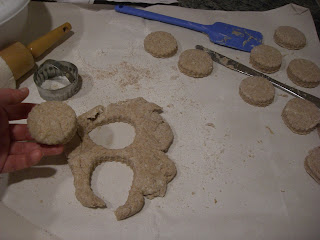
I think I ate five of these today. I hope not. I hope it was only four. At least they were small. My biscuit cutter is only 2" in diameter. I have a larger one, but I'd rather use the smaller one, so that if I eat five of them, I won't have done too much damage.
Can you tell I love biscuits? Maybe that means I'm a Southern girl at heart, except that I don't like the really rich and buttery biscuits. It's overkill. I'd rather spread the butter on top than have oodles of it already baked into the biscuit. My default biscuit is the HeartSmart Bisquick mix, but it's all white flour and no fiber. Whole-wheat foods (and high-fiber grains) are really calming to my stomach, and since my stomach's been jumpy lately, I've been eating everything whole-wheat that I can get my hands on.
The first time I made these, I thought they were so-so, but now I can't get enough of them. They're a little chewier than regular biscuits, but that's to be expected with anything whole-wheat, and they still have that wonderful biscuit flavor. They taste delightful with just a little bit of that Earth Balance margarine spread on top...
I adapted the recipe a little from this site. You can find a nutritional analysis there, too.
Whole Wheat Biscuits
1 cup all-purpose flour (yes, there's some white flour, to keep the biscuits from being too dense)
1 cup whole-wheat flour
1/2 tsp. baking soda
1 Tbsp. baking powder (yes, 1 tablespoon)
1/4 tsp. salt
Oat bran or wheat bran (optional--I like oat bran in biscuits because you can't see or taste it, and it adds fiber. It doesn't affect the actual baking, so there's no need to use a precise quantity)
3 Tbsp. stick margarine
2/3 cup skim milk mixed with 2 tsp. lemon juice (unless you just happen to have non-fat buttermilk in the house, in which case you should use 2/3 cup of that instead)
1. Thoroughly mix the dry ingredients (flours, baking soda, baking powder, salt, and bran) in a bowl.
2. Cut the margarine into the dry ingredients. Use a pastry blender if you have one; otherwise, use some cutlery. The standard method is with two knives, but I prefer to use a knife and a fork.
3. Add the milk/lemon juice mixture (or the buttermilk) and stir well. Pretty soon it will be too doughy to stir; when this happens, turn it out onto a floured workspace, add the bits of dough still left in the bowl, and knead until it's well-mixed.

4. Roll it out with a rolling pin. It stretches back (like puff pastry, which I found to be a nightmare), but with a combination of pressing and rolling you can get it rolled out to about 1/2" thick. Cut out your biscuits with a biscuit cutter (or an improvised biscuit cutter) dipped in flour. Put them on a cookie sheet lined with parchment paper (or a non-stick cookie sheet, but then you have to wash it).
5. Get out the oven (unless you're fortunate enough to have a built-in oven) and preheat it to 325 degrees. Bake for 12-15 minutes. It's hard to tell when they're done, but if you're unsure, err on the safe side. You can always put them back in, but you can't "undo" those last few minutes of cooking time. (Wouldn't that be nice?)
Makes 16-18 small biscuits. For larger biscuits, the recipe says it'll make 8. These biscuits don't keep that long (only a couple of days). I generally freeze half of them and store the other half on the counter. When the counter biscuits are gone, I get out the frozen ones. Of course, if you devour them all the day you make them, it doesn't really matter, does it?
No comments:
Post a Comment